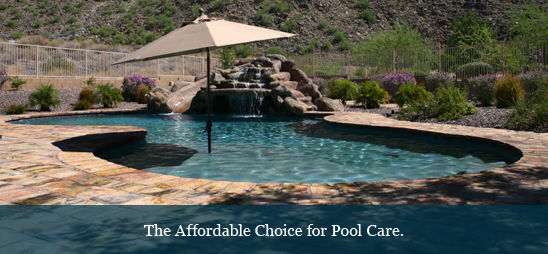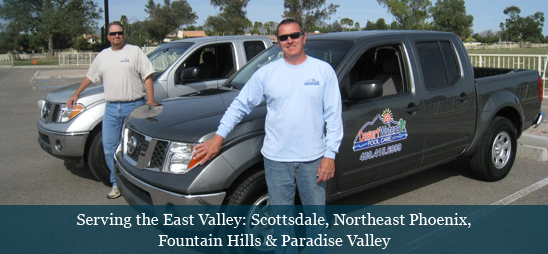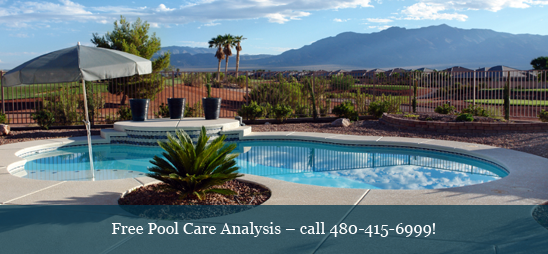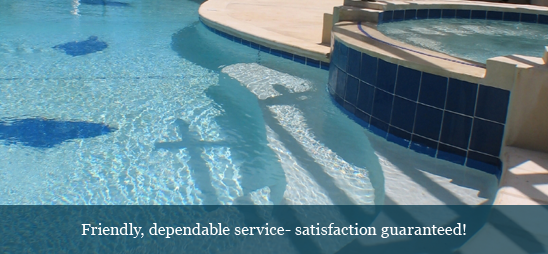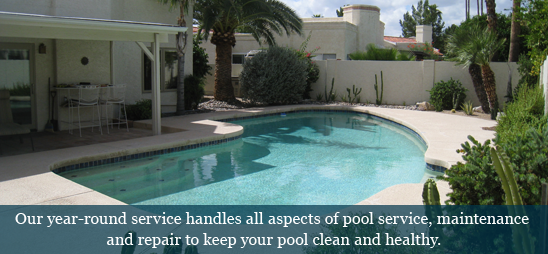Pool Filter Maintenance
Preserve the life of your pool equipment and save on pool expense by having your pool technician perform this simple, low cost, very important maintenance procedure. There are three types of pool filters: DE, Cartridge, and Sand.
DE (Diatomaceous Earth) Filters
DE filters are the most effective and can filter out particles as small as 5 microns. They have grids inside which must be coated with DE powder. They are kept clean by periodic backwashing. If backwashing is no longer effective, it is necessary to disassemble and clean the filter. Generally, a DE filter should be cleaned two to three times a year, depending on usage, type of cleaning equipment in the pool, and surrounding vegetation. DE filter cleaning is necessary when impurities coat the DE grids and create a thick, muddy paste that doesn't come out with backwashing. Over time, especially during the Monsoon season, and after an algae infestation, huge chunks of thick, muddy paste clog the spaces between the grids. Filter grids need to be replaced when torn or showing wear.
When is backwashing necessary?
When the pressure on your DE filter raises 8 to 10 lbs. per square inch over the clean starting pressure, the filter must be backwashed. Backwashing removes all the dirty DE media, dirty water and any other debris in the filter tank.
What is the process for cleaning DE filters?
The whole filter is taken apart and the DE grids are hosed off and inspected, along with the manifold (which holds the grids together) and the manifold gasket. All debris is cleaned out of the bottom of your filter and the grids are placed back into their proper position. After the filter gasket is lubed, the tank is put back together, while inspecting for leaks.
Grids – why are they important?
If a grid is torn, it will allow dirt, algae and other impurities to pass right through the filter, returning them to your pool. If even one grid is torn, we recommend that all eight grids be replaced. This is because if one grid went, the others are sure to follow. It will cost more money to open the filter up and take all the grids apart a second time than it will to simply replace them all the first time.
Contact Desert Waters Pool Care today to learn more or schedule DE filter maintenance.
Cartridge Filters
Cartridge filters will filter better than sand filters, but not as well as DE filters. Cartridge filters can trap particles as small as 25 microns. Cartridge filters require cleaning periodically. The average filter cartridge needs to be replaced every two to three years. Replacement cartridges can be expensive, particularly for larger filters where multiple cartridges are used.
Cartridge filters need to be cleaned because ALL of the impurities that are filtered out of your pool are now trapped in the filament of your cartridge(s). Because cartridge filters are unable to be backwashed, the only way to remove the impurities is to open the filter and clean the cartridges. When cartridge filters are not cleaned regularly, they break down, costing considerably more than a filter cleaning.
How often do cartridge filters need to be cleaned?
Cartridge filters need to be cleaned three to four times a year depending on your pool usage and the surrounding vegetation in your yard. Failure to clean cartridge filters reduces their life span, as well as their effectiveness, forcing your pool pump to run harder and longer for the same results. The excess wear on your pump may eventually cause it to fail, making it necessary to purchase a new pump.
What is the process for cleaning cartridge filters?
Cartridge filter systems can have anywhere from one to eight individual filters. Filters are taken apart and rinsed carefully, starting at the top of the cartridge and going down each sleeve, spinning the cartridge in 360 degree fashion until all the sleeves are free of impurities on all of the elements. Cartridges that have brown areas or cracks in the upper and lower manifolds may need to be replaced as impurities will circulate back into the pool. Once the filter has been put back together with the o-ring lubed, the equipment is turned on and checked for leaks.
Contact Desert Waters Pool Care today to learn more or schedule cartridge filter maintenance.
Sand Filters
Sand filters cost the least and are the least effective of the 3 types of filters. Sand filters can trap particles as small as 50 microns (10 times as large as DE filters). They are easy to maintain – all they require is periodic backwashing
When should I backwash my sand filter?
Sand filters should be backwashed when the pressure reaches 10 PSI higher than it was when it started (when the pool was clean).
What else do I need to do to maintain a sand filter?
You should lubricate the backwash handle twice a year.
How often do I need to change the sand?
Every five years. If the sand isn't changed, pool water can become cloudy even if the water chemistry is correct. When new, the filter sand is very rough and this makes it very effective in filtering. As this roughness is smoothed out, the filter loses efficiency, requiring your system to run longer and harder to filter. It also increases amount of chemicals needed, increasing your TDS (Total Dissolved Solids) levels.
What is the best type of sand to use?
Opinions vary, but synthetic sand or ZeoSand is becoming more widely used. The manufacturers state that it filters to five microns, considerably better than normal sand (50 microns). It is more expensive than regular sand – about three times the cost – but this is offset by the fact that you only need half as much sand in the filter.
Contact Desert Waters Pool Care today to learn more or schedule sand filter maintenance.
Pool Maintenance
When Should You Drain & Clean Your Pool
Draining and sanitizing (acid wash or chlorine bath) your pool is usually a three day process, so it's best to do it at a time when you aren't planning on using your pool. Swimming pools should be drained in the off swimming season – not in the extremely hot weather of Arizona summers. Except for Pebbletec, most pools must be drained when the temperature is no higher than 80 degrees. This process should only be done by pool professionals. Without certain safeguards, draining your pool can cause serious damage to its structure.
How often does a pool need to be drained?
Ideally, pools should be drained every two years to five years, depending on usage. Sometimes it's obvious that the pool needs to be drained because pool cleaning can no longer remove algae and your pool's filter cannot remove debris from the water. Massive amounts of chemicals have to be added to combat the formation of algae, especially in the summer.
I haven't drained my pool in years. It looks fine and the chemical levels are good, so why should I drain it?
Often chemicals will register as present even though they ARE NOT WORKING. Think of it this way – all the chemicals added over the years, all the people scum, urine, pets, dead animals and other dirty things that can end up in your pool: do you want to swim in that? To keep a healthy balance, your pool needs to be drained every two to five years.
How Do I Know My Pool Needs Draining?
There are three health issues that develop over time for which draining your pool is the only solution, no matter how well you or your weekly pool service take care of your pool. The newer the water, the healthier it is for your family to swim in.
Problem 1: High Calcium Levels. Results in scale formation on the pool surfaces as well as scaling in the pipes, plumbing and filter. Water becomes dull and cloudy. High levels irritate swimmers, in particular causing sore eyes.
Problem 2: High Cyanuric Acid Levels. Reduces the effectiveness of your chlorine, causing stains and cloudy water. Greater amounts of chlorine are needed to maintain your pool. The main reason why cyanuric acid / Stabilizer increases quickly is that CYA is in every chlorine tab that is put in your pool. The optimum level of Cyanuric Acid in a swimming pool is about 20-50 ppm (parts per million). Above that your pool requires more and more Chlorine, which can cause problems for swimmers.
Problem 3: Total Dissolved Solids. TDS is everything in the water that's not actually water. A high TDS level (above 1500 ppm) will:
- 1. Corrode metal equipment and accessories, even though the water is balanced.
- 2. Cause eye/skin irritation, even when the pH is right.
- 3. Allow algae to form and multiply, even with a 2 to 3 ppm chlorine residual.
Will draining alone remove all the calcium and all the cyanuric acid?
While it will greatly reduce those levels, it will not remove them completely as both calcium and cyanuric acid adhere to the pools surface.
Desert Waters' Pool Drain & Clean Services
Acid Washing
This sanitizing process is the only way to remove the calcium and cyanuric acid that has adhered to your pool's surface. Note: this process will not remove the calcium line on the tile. That calcium line has to be pressure blasted off, which we can also do for you.
Drain, acid wash and fill service starts at $595.
Contact Desert Waters Pool Care to schedule a swimming pool drain and acid wash.
Chlorine Bath
A chlorine bath is done when there are large amounts of algae in a pool or when "black algae" is present. After draining, the entire pool is coated with a special mixture of chlorine, applied most liberally to areas of intense algae growth. This process will kill most of the algae. The entire surface of the pool is scrubbed with a special brush to remove the remaining algae.
Drain, chlorine bath and fill service starts at $295.
Contact Desert Waters Pool Care to schedule a swimming pool drain and chlorine bath.
Pool Tile Cleaning
Calcium buildup can make a mess of your swimming pool tiles by creating an unsightly water line. Our cleaning process can restore tile to its original beauty. We remove calcium build-up and other stains on tile, Pebble Tec, or natural rock. We use an environmentally friendly process (safe for pets and plants) that gently removes calcium, mold, mildew and hard water deposits. The cleaning process is aggressive enough to remove the toughest deposits, but gentle enough to not damage the grout or scratch the tile glaze.
Tile Cleaning PricingOur price for cleaning tile is typically between $3 and $4 per linear foot with a minimum of $250.
Exact pricing per linear foot depends on several factors:
- 1. Thickness of calcium buildup
- 2. Tile vs. Pebbletec
- 3. Overall footage
Special features, such as waterfalls, walls, imbedded rock formations or negative edges, require more time and will be quoted on a square foot basis.
Contact Desert Waters Pool Care to schedule a pool drain and tile cleaning.


Thank you so much for all your help. Also wanted to say that you guys are really awesome and I am already so impressed with your work, ethics, and communication. I will definitely be recommending you to everyone I know that has a pool.-Cindy
I would highly recommend Desert Waters Pool Care. We're really impressed with the skill level and quality of service rendered. They not only stand behind their work, but go above and beyond what I see other pool companies do.-Simon
Thank you for your great service! You have far exceeded my expectations. I can always count on you to be here on my scheduled service day and do a great job!-Denise

